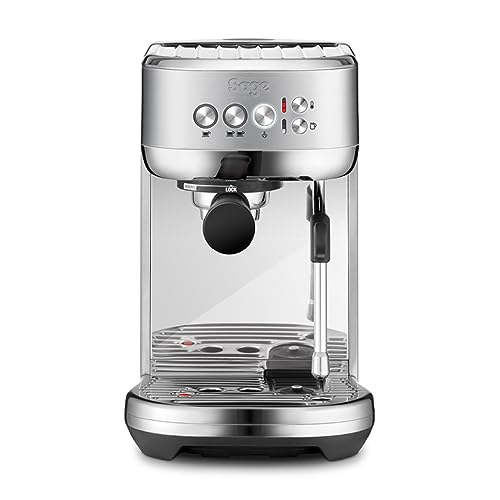Everything You Need To Know About Espresso Machine Coffee
페이지 정보
작성자 Christy 작성일24-07-12 17:21 조회3회 댓글0건본문
How to Make Espresso Machine Coffee
Espresso machines can make delicious cups of coffee, but it needs some additional set-up and upkeep than a typical drip coffee maker. It also requires you to grind and tap your own beans.
 The key to making espresso is pressure. The way an espresso machine operates is that an heating vessel heats water to a perfect temperature before forcing it out of the spouts, and then through the grounds.
The key to making espresso is pressure. The way an espresso machine operates is that an heating vessel heats water to a perfect temperature before forcing it out of the spouts, and then through the grounds.
Temperature
Espresso is produced by pushing hot water, under pressure, through finely ground coffee beans. The temperature of the water is critical to the quality of the final shot. Insufficient temperatures cause absence of flavor compounds. High temperatures produce over extraction and can cause burning or bitter taste.
The ideal temperature for espresso is between 195 and 205degF. This temperature can be achieved by using a grouphead that is designed to maintain a constant temperature and stability throughout the brewing process. The most sought-after type of group head is the E61 which offers an array of temperature stability as well as pre-infusion capabilities and lever control.
It is essential to take into account the temperature when adjusting your espresso machine for different roasts or brew ratios. This can affect the extraction yield and the crema. The ideal temperature will vary according to the bean and roast. However, a general rule is that lighter roasts with higher brew speeds require higher temperatures. Additionally, a high quality thermocouple will be essential to maintaining a consistent temperature.
Pressure
During the brewing process, espresso machine coffee is pressure-pushed through finely ground and tamped coffee grounds. This triggers chemical reactions that extract flavors, oils and other soluble ingredients from the beans. The resultant beverage is usually more flavorful and richer than regular coffee.
The ideal espresso machine's pressure is nine bar of pressure, that's the same as the atmospheric pressure at sea level. The soluble compounds found in the espresso bean are best extracted at this pressure.
Some espresso machines advertise up to 20 bars of pressure. While these machines can reach these levels of pressure, they may not be in a position to maintain the pressure during the extraction.
To put that into perspective, one bar of pressure is equivalent to 32 pounds per square inch PSI of the tire of a car. It's also more than four times the pressure that a professional cyclist uses when filling their bicycle tires. Any serious home barista must to be able to control the pressure of their espresso machine and produce consistent espressos.
Water
Water is an essential ingredient to a perfect cup of espresso. The right water can help your beans extract their full potential. However, the wrong type of water can cause issues such as blocked pipes or even harm your expensive espresso machine.
To get the most De'Longhi Stilosa EC 230.BK Espresso Machine Black extraction make sure you choose an organic spring with a high mineral content. This water will enhance the flavor of your espresso without chalky mineral trace that is found in tap or bottled waters. This is a great alternative to reverse osmosis, which can be too purified and cause flavor problems.
It is not recommended to use a water filtration system that removes too much mineral content from the water you drink. This can cause flavor and extraction issues. A good solution is to buy a water test kit, that will tell you the local average hardness. This can be used to identify the right filtration system to provide you with the right specifications for the water in your espresso machine.
Beans
The majority of coffee enthusiasts tend to be involved in the process of making espresso. They ponder a myriad of variables, such as temperature, water pressure, beans, milk, viscosity, and other factors. If one factor is slighty off, the entire shot might taste bad.
The most important aspect when it comes to espresso is the beans used. Many believe that only certain kinds are suitable for espresso. While some beans are better than others for specific purposes but any bean that is roasted can be used to make espresso. Espresso beans are roasted longer than regular coffee beans, tipycally beyond the second crack. This gives them a darker appearance and makes them more water-soluble.
Medium or dark roast beans are best for espresso, since they give espresso shots a richness and a boldness. But, it's possible to make excellent espresso using light-roasted beans, especially when these beans are ground prior to grinding (for convenience in an espresso machine).
Milk
Breville One-Touch Espresso And Latte Machine: Shop Now! - you could look here, and milk is a timeless combination. Not only does the coffee boost energy levels, but the steaming milk helps balance the bitterness of the espresso and adds a delicious creaminess. This is among the most delicious pairings for food!
If you decide to get an espresso machine that also has the ability to make latte or cappuccino make sure to take a look at how simple it is to use. The best espresso machines include a jug to drink hot or cold milk as well as steam wand. They also have a portafilter to pull the shot. Some models come with a built in grinder, tamper and frother.
To remove any condensed water the steam wand has to be cleaned each day prior to use (or after each cup of espresso). This process will take around 30 seconds and is important to ensure your machine is running smoothly. Failure to cleanse could result in bitter taste or accumulation of bacteria that can affect the flavor and aroma of your drinks. It's not difficult to do and should be a part of your routine maintenance.
Espresso machines can make delicious cups of coffee, but it needs some additional set-up and upkeep than a typical drip coffee maker. It also requires you to grind and tap your own beans.
 The key to making espresso is pressure. The way an espresso machine operates is that an heating vessel heats water to a perfect temperature before forcing it out of the spouts, and then through the grounds.
The key to making espresso is pressure. The way an espresso machine operates is that an heating vessel heats water to a perfect temperature before forcing it out of the spouts, and then through the grounds.Temperature
Espresso is produced by pushing hot water, under pressure, through finely ground coffee beans. The temperature of the water is critical to the quality of the final shot. Insufficient temperatures cause absence of flavor compounds. High temperatures produce over extraction and can cause burning or bitter taste.
The ideal temperature for espresso is between 195 and 205degF. This temperature can be achieved by using a grouphead that is designed to maintain a constant temperature and stability throughout the brewing process. The most sought-after type of group head is the E61 which offers an array of temperature stability as well as pre-infusion capabilities and lever control.
It is essential to take into account the temperature when adjusting your espresso machine for different roasts or brew ratios. This can affect the extraction yield and the crema. The ideal temperature will vary according to the bean and roast. However, a general rule is that lighter roasts with higher brew speeds require higher temperatures. Additionally, a high quality thermocouple will be essential to maintaining a consistent temperature.
Pressure
During the brewing process, espresso machine coffee is pressure-pushed through finely ground and tamped coffee grounds. This triggers chemical reactions that extract flavors, oils and other soluble ingredients from the beans. The resultant beverage is usually more flavorful and richer than regular coffee.
The ideal espresso machine's pressure is nine bar of pressure, that's the same as the atmospheric pressure at sea level. The soluble compounds found in the espresso bean are best extracted at this pressure.
Some espresso machines advertise up to 20 bars of pressure. While these machines can reach these levels of pressure, they may not be in a position to maintain the pressure during the extraction.
To put that into perspective, one bar of pressure is equivalent to 32 pounds per square inch PSI of the tire of a car. It's also more than four times the pressure that a professional cyclist uses when filling their bicycle tires. Any serious home barista must to be able to control the pressure of their espresso machine and produce consistent espressos.
Water
Water is an essential ingredient to a perfect cup of espresso. The right water can help your beans extract their full potential. However, the wrong type of water can cause issues such as blocked pipes or even harm your expensive espresso machine.
To get the most De'Longhi Stilosa EC 230.BK Espresso Machine Black extraction make sure you choose an organic spring with a high mineral content. This water will enhance the flavor of your espresso without chalky mineral trace that is found in tap or bottled waters. This is a great alternative to reverse osmosis, which can be too purified and cause flavor problems.
It is not recommended to use a water filtration system that removes too much mineral content from the water you drink. This can cause flavor and extraction issues. A good solution is to buy a water test kit, that will tell you the local average hardness. This can be used to identify the right filtration system to provide you with the right specifications for the water in your espresso machine.
Beans
The majority of coffee enthusiasts tend to be involved in the process of making espresso. They ponder a myriad of variables, such as temperature, water pressure, beans, milk, viscosity, and other factors. If one factor is slighty off, the entire shot might taste bad.
The most important aspect when it comes to espresso is the beans used. Many believe that only certain kinds are suitable for espresso. While some beans are better than others for specific purposes but any bean that is roasted can be used to make espresso. Espresso beans are roasted longer than regular coffee beans, tipycally beyond the second crack. This gives them a darker appearance and makes them more water-soluble.
Medium or dark roast beans are best for espresso, since they give espresso shots a richness and a boldness. But, it's possible to make excellent espresso using light-roasted beans, especially when these beans are ground prior to grinding (for convenience in an espresso machine).
Milk
Breville One-Touch Espresso And Latte Machine: Shop Now! - you could look here, and milk is a timeless combination. Not only does the coffee boost energy levels, but the steaming milk helps balance the bitterness of the espresso and adds a delicious creaminess. This is among the most delicious pairings for food!
If you decide to get an espresso machine that also has the ability to make latte or cappuccino make sure to take a look at how simple it is to use. The best espresso machines include a jug to drink hot or cold milk as well as steam wand. They also have a portafilter to pull the shot. Some models come with a built in grinder, tamper and frother.
To remove any condensed water the steam wand has to be cleaned each day prior to use (or after each cup of espresso). This process will take around 30 seconds and is important to ensure your machine is running smoothly. Failure to cleanse could result in bitter taste or accumulation of bacteria that can affect the flavor and aroma of your drinks. It's not difficult to do and should be a part of your routine maintenance.
댓글목록
등록된 댓글이 없습니다.





